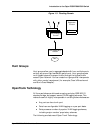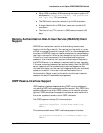
Cajun P550R/P880/P882 Switch User Guide
Introduction to the Cajun P550R/P880/P882 Switch
1-19
■
When DNS is enabled, DNS names can be used in place of IP
addresses for ping, telnet, connect, and traceroute
and copy tftp
CLI commands
■ The DNS client name can consist of up to 255 characters
■ A single label within a DNS client name can consist of 63
characters
■ The time to live (TTL) value in a DNS resource record is 24
days.
Remote Authentication Dial-In User Service (RADIUS) Client
Support
RADIUS is a mechanism used for authenticating remote users
logging into the Cajun switch. You can log into the switch in order
to view or manage the switch through the CLI or the embedded web
interface. A RADIUS client provides a mechanism for consolidating
user login information. When a user attempts to log into the switch,
if there is no local user account for the entered user name and
password, then the switch will send an Authentication Request to
the RADIUS server in an attempt to authenticate the user remotely.
If the user name and password are authenticated, then the RADIUS
server responds with an authentication acknowledgement that
includes information on the user’s privileges and the user is allowed
access to the switch. If the user is not authenticated, then a
Authentication Reject is sent to the switch and the user is denied
access to the switch’s embedded management.
OSPF Passive-Interface Support
OSPF passive-interface disables sending OSPF routing updates by
not sending OSPF hello packets across the network. Any OSPF hello
packets received from other OSPF routers on the network are also
ignored. OSPF advertises the passive-interface as a stub network in
the router updates it sends to other OSPF interfaces.
The OSPF passive-interface CLI commands are:
>passive-interface [<interface-name>|<ip-
addr>]
This command defines an OSPF interface as passive-interface.
>no passive-interface [<interface-name>|<ip-
addr>]


















